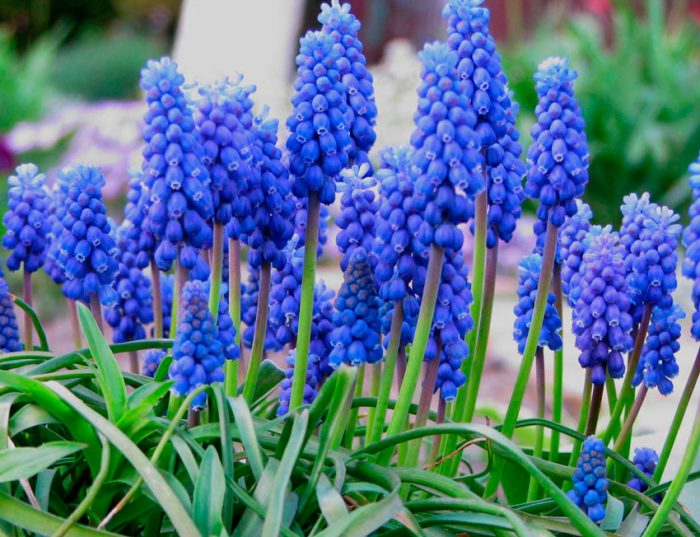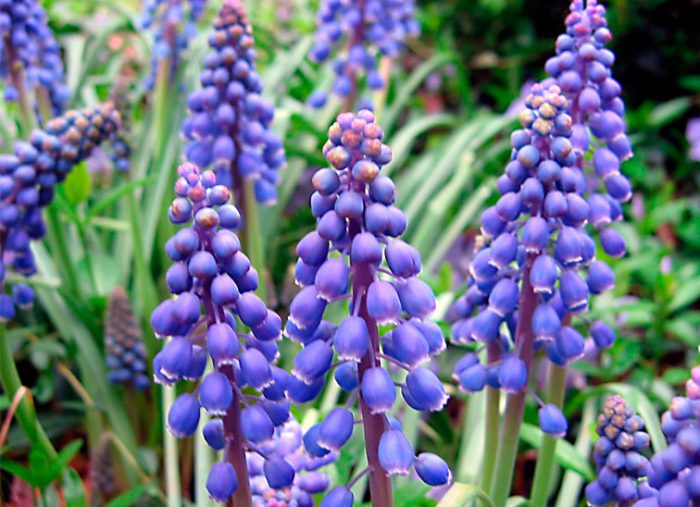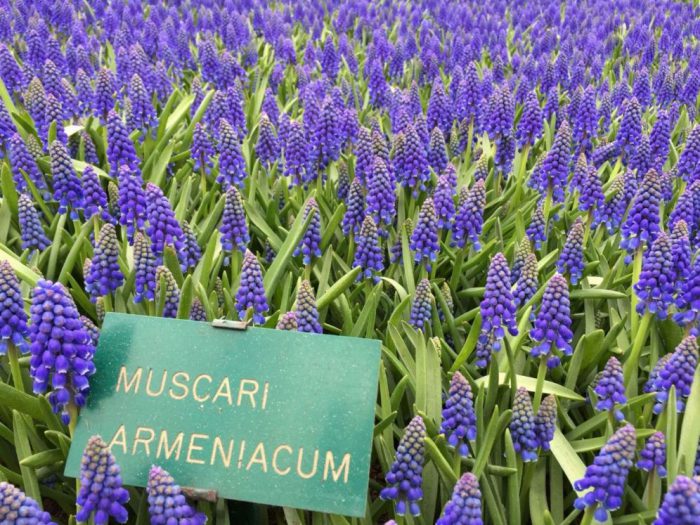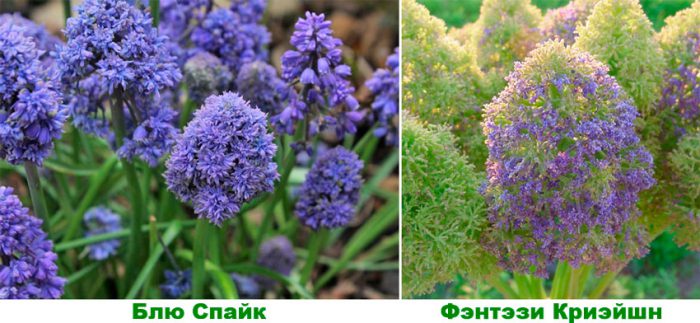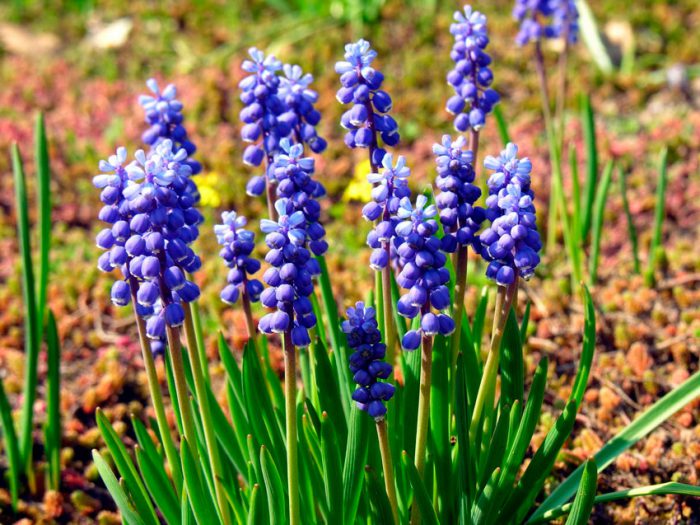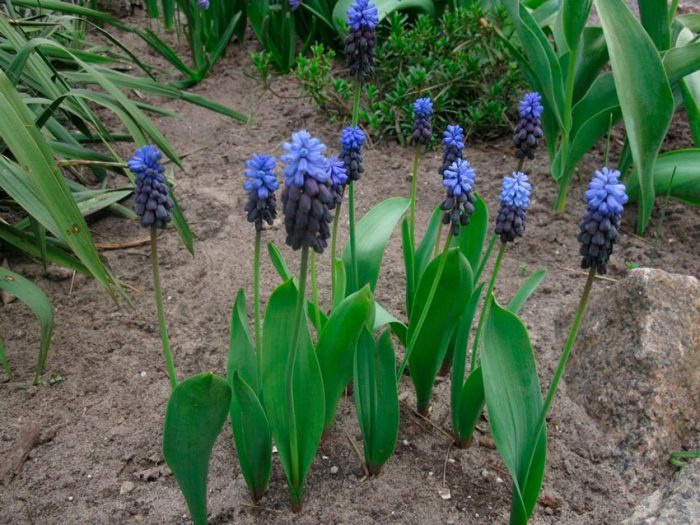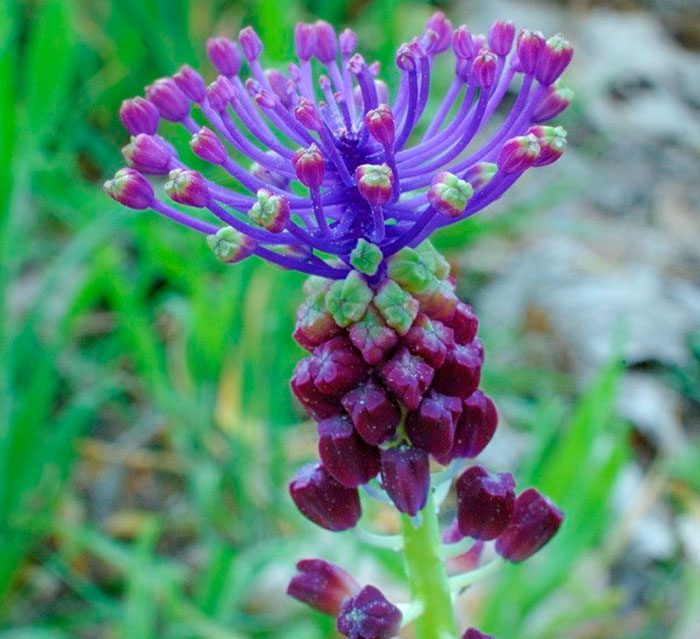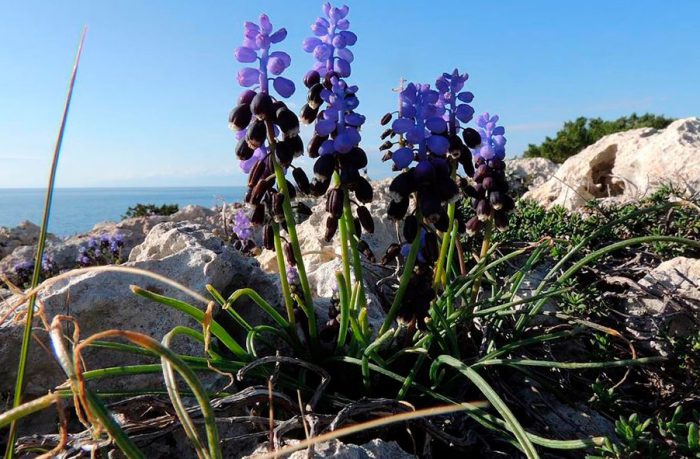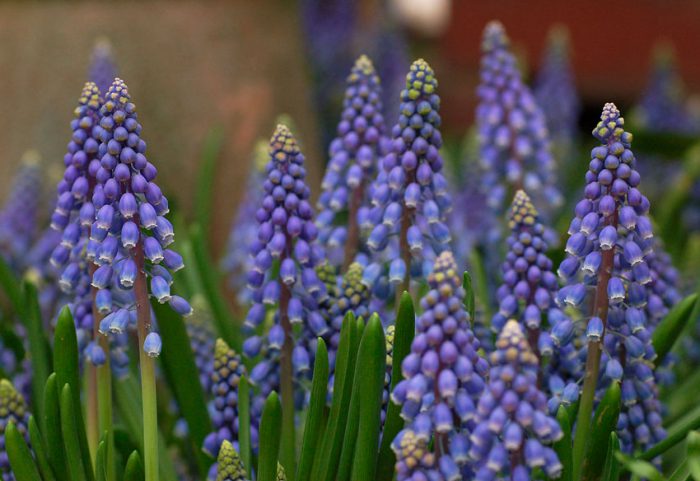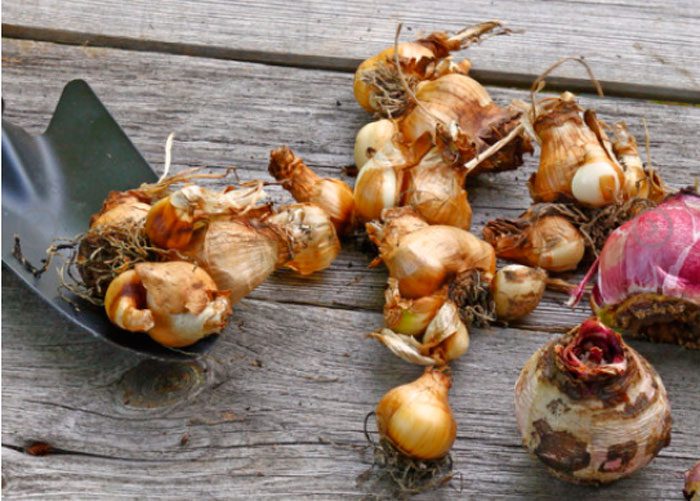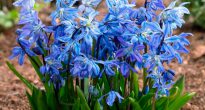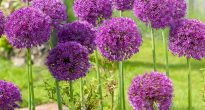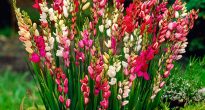Muscari (Muscari) is also called mouse hyacinth or viper onion. This bulbous perennial belongs to the Asparagaceae family, but earlier this genus was a member of the lily or hyacinth family. This genus unites about 60 species. In natural conditions, such plants can be found on the edges of the forest, among the bushes, as well as on the mountain slopes of the Caucasus, Crimea, South and Central Europe, Asia Minor and the Mediterranean. These plants are among the earliest spring flowers and are very often cut. Muscari flowers have a very strong, but quite pleasant scent. Small but very effective muscari flowers decorate lawns, rock gardens and rabatki. Such flowers are also used as border plants.
Content
Muscari features
Ovate muscari bulbs have light colored outer scales. The bulbs reach 20 mm in diameter and 15–35 mm in length. The length of the basal linear leaf plates reaches 17 centimeters, they grow up to 6 pieces on one copy. The leaves grow in spring, but they can reappear in the fall. In height, such plants can reach about 0.3 meters. On the leafless peduncle there are flowers, the perianth of which are barrel-shaped, cylindrical or tubular in shape, consist of 6 fused petals, bent along the edge. The color can vary from dark blue to white. The diameter and length of the flowers are 5 mm. Such flowers are part of dense apical or racemose inflorescences, which can reach about 8 centimeters in length. The fruit is a three-celled winged capsule that has a heart-shaped or spherical shape, they contain small wrinkled black seeds. The seeds remain viable for 12 months after harvest. The advantages of the muscari genus are that almost all species have a high decorative effect, and such plants are also distinguished by their unpretentiousness.
Types and varieties of muscari with photos
Armenian Muscari (Muscari armeniacum)
The winter-hardy Armenian muscari (Colchis) is very popular among gardeners. Its flowering begins in late spring and lasts about 20 days. This particular species is called "mouse hyacinth". The flowers located in the upper part of the inflorescences are sterile, and they are painted in light blue. The dark blue flowers at the bottom of the peduncle have a white border. The flowers have a pleasant smell.
Most popular varieties:
- Muscari Terry Blue Spike... It has a very high decorative effect due to the fact that up to 170 flowers are included in the grape-shaped inflorescence. Differs in unpretentiousness, is often used for cutting.
- Christmas Pearl... It has very decorative purple flowers.
- Fantasy Creation... A very effective variety due to the combination of greenish blue and blue colors.
Muscari uviform (Muscari botryoides)
Under natural conditions, this species can be found in the alpine belt of Central and Southern Europe. It is considered the most popular among gardeners since 1576. The flowers of this species are somewhat smaller in comparison with the Armenian muscari. Almost all varieties are colored in different shades of blue, but there are 2 varieties:
- V album... The cluster-like inflorescences consist of white flowers similar to pearls.
- V carneum... The flowers are pink in color.
Muscari broadleaf
The leaf plates of this species are very wide and similar to tulip foliage. Inflorescences are dense, cylindrical in shape and dark blue in color. It stands out among other species in that several peduncles can grow from one bulb at once.
Pale Muscari (Muscari pallens)
In natural conditions, it can be found on the mountain slopes. Peduncles are low, and small bell-shaped flowers of light blue color appear on them. The most popular variety is White Rose Beauty: the color of its flowers is light pink.
Muscari crested (Muscari comosum)
A very effective look. In the wild, it prefers to grow among shrubs, on the edges of forests, as well as in dry meadows. On the peduncle is a crest, consisting of purple flowers with arcuate pedicels. This type looks very impressive on lawns or lawns against the background of ground cover grass. The most popular variety is Plumozum: the shoots are highly branched, and they have a large number of sterile purple-purple flowers.
Muscari Oche, or Tubergena
In nature, it can be found in Northwestern Iran. Flowering occurs in mid-spring. Blue flowers have teeth of a lighter color. Good drainage is essential. The most popular among gardeners is the Tubergen variety, which has flowers of a paler color, and the shape of its leaf plates is sickle-shaped.
Muscari pretty (Muscari pulchellum)
This species has a Hebrew name that sounds like kadan nae (beautiful). You can meet such flowers in the parks of Ashkelon. They begin to bloom in winter. Peduncles are low, and on them there are dense short ovoid inflorescences with a deep blue color. The fold teeth are white.
In addition to these species, the following are also very popular among gardeners: long-flowered muscari, changeable, ragweed, white-grass, large-fruited, strange, multi-flowered, dense-flowered, racemose, etc.
Growing muscari in the garden
These flowers are quite popular in gardening. They look very good both in decorative vases and in rock gardens, while undersized varieties are used as curbs. Muscari also look very impressive in multi-tiered flower beds, in composition with other plants blooming in spring. So, against the background of a dense planting of blue-lilac muscari, islets of early flowering daffodils and tulips, which are slightly higher, look incredibly beautiful. Also, orange hazel grouses look great next to blue muscari.
Like other early-blooming spring flowers, muscari begin to bloom when there are no leaves at all on the bushes and trees. In this regard, there is always enough sunlight for such plants. These flowers can do without transplanting for several years in a row, so experienced gardeners are advised to plant them in the immediate vicinity of a perennial plant that does not need relatively frequent transplants. Loose, nutrient-rich and water-permeable soil is very suitable for planting. Experts advise choosing a site for muscari that is located on an elevation, while it must be protected from strong gusts of wind.
Planting muscari in open ground
What time to plant
It is recommended to disembark in autumn until the last days of October. It is best to plant plants in groups, while it should be borne in mind that you can plant only those muscari bushes that have been grown in the same place for 5 years or longer. When buying planting material in a specialized store, you should pay special attention to the condition of the shoots. They should not show signs of illness. In April, sometimes in nurseries, you can see muscari seedlings, which are already blooming with might and main, while the sellers assure that these plants can be immediately transplanted to a permanent place. You can try to follow their advice.
How to plant
Before proceeding with the landing, it is necessary to inspect the bulbs, while removing those of them that are injured or darkened. For preventive purposes, the planting material must be disinfected, for this it is placed for 30 minutes. in a solution of karbofos (2%). Then it is taken out and immersed in a solution of potassium manganese (1%) for half an hour. Also, 24 hours before planting the bulbs, it is necessary to prepare the planting holes, they should be watered abundantly so that the entire layer of soil is soaked. Before planting, the bottom of the holes is covered with a layer of river sand, which will serve as good drainage. Large bulbs are buried 7 centimeters into the soil, while leaving a distance of 5 to 10 centimeters between the specimens. Small bulbs need to be buried 3 centimeters into the ground, while leaving 2 to 3 centimeters of empty space between the specimens.


Watch this video on YouTube
Care features
Caring for muscari is quite simple, so even a novice gardener can grow this plant. Watering such a flower is necessary only at the very beginning of active growth, however, at this time, most often, the soil contains a large amount of moisture after the snow cover melts or after heavy spring rains. When the plant is dormant, it does not need watering. Systematic watering is needed only if the winter period turned out to be little snow or there was very little rain in the spring.
In the event that the soil on the site contains a small amount of nutrients, then it becomes necessary to apply organic fertilizer to the soil. So, in the autumn, during digging, compost or humus can be added to the soil, while 1 m2 5 kg of fertilizer is taken. In the event that such fertilizer is systematically applied to the soil in the autumn, then muscari can be grown on the same plot for 10 years. However, in the end, you still have to transplant such plants.
Bloom
Flowering lasts a little longer than 20 days. At this time, you should only regularly loosen the soil surface (after watering), while you need to be very careful so as not to injure the bulb. It is also necessary to carry out timely weeding and, if necessary, cut off fading flowers. If you notice that over time, the flowers of the plant began to lose their former decorativeness, then this means that the muscari must be planted.
Transfer
Muscari can be propagated vegetatively with babies separated from the mother's bulb. In this way, the plant is propagated in the fall at the same time when the site is being digged (from the middle to the last days of October). Transplanting should be done only on those bushes that have been growing in the same place for 5 to 6 years. However, you can understand that muscari needs a seating arrangement by its appearance. The bulbs must be dug up, and then separated from the mother's babies (there are up to 30 of them). Then the bulbs will need to be planted in the manner described above.
Reproduction of muscari
The vegetative method of reproduction is described above. In addition, muscari reproduces very well by self-seeding. In order to control the number of these flowers, after they have faded, it is recommended to remove all peduncles, if necessary, leaving a few pieces. When the seeds are ripe, they will need to be harvested. It should be remembered that they remain viable for 12 months. Sowing should be done in open ground in autumn, while the seeds should be buried 10–20 mm. Seedlings will appear in the spring, and they will look like thin strings. The flowering of muscari grown from seed is observed only after 2 or 3 years.
Diseases and pests
Very often, this plant is sick with mosaics, and it arises from the yellow dwarf onion virus. In an infected specimen, a green mosaic can be seen on the surface of the leaf plates, and they themselves become narrowed, the flower arrow is shortened, and the growth of the plant itself is inhibited. In some cases, muscari is infected with the usual cucumber mosaic, in which case the leaves are deformed, and light green strokes and spots appear on their surface. The carriers of these viruses are aphids, and if it is in the onion, it will remain there. In this regard, all diseased plants must be dug up and destroyed in order to stop the spread of the virus. For the purpose of prevention, it is recommended to promptly destroy aphids on the site. To do this, you can use a soapy solution. To prepare it, 2 large lodges of soap (Fairy, Gala) must be mixed with 0.5 liters of water. When spider mites appear, plants should be treated with means of the avermectin group (Aktofit, Vertimek, Fitoverm), spraying should be carried out at a temperature of 18 degrees, while strictly adhering to the instructions.
Muscari after flowering
At the end of flowering, it is necessary to carefully cut off all flower stalks and feed them with liquid phosphorus-potassium fertilizer to prepare the bulbs for wintering. Watering the muscari should be less and less. When the leaves on the bushes are completely dry, you need to stop watering them altogether. In the autumn, it is necessary to dig up the site, and plant the bushes of five years old. From the bushes that are not transplanted this year, you need to remove the old leaf plates. Plants that have been transplanted or planted must be sprinkled with a layer of mulch (peat).
Storing muscari bulbs
Digging the bulbs for the winter is not at all necessary, but it is possible. But in order to preserve planting material until spring, you need to know a few rules:
- After the leaves of the muscari begin to dry out, you need to start digging up the bulbs.
- The bulbs are dried for several days, then they are placed in moistened clean sand or peat.
- Once every 7 days, it is necessary to inspect the planting material, while rotten, injured or soft bulbs should be discarded.
- It is recommended to store the bulbs at an air humidity of 70 percent and at a temperature of -17 degrees.
However, it should be remembered that it is recommended to plant such a plant in the autumn, therefore, there is no particular need to save the bulbs until spring.


Watch this video on YouTube

